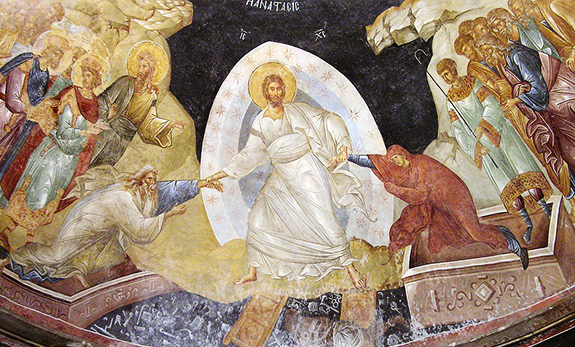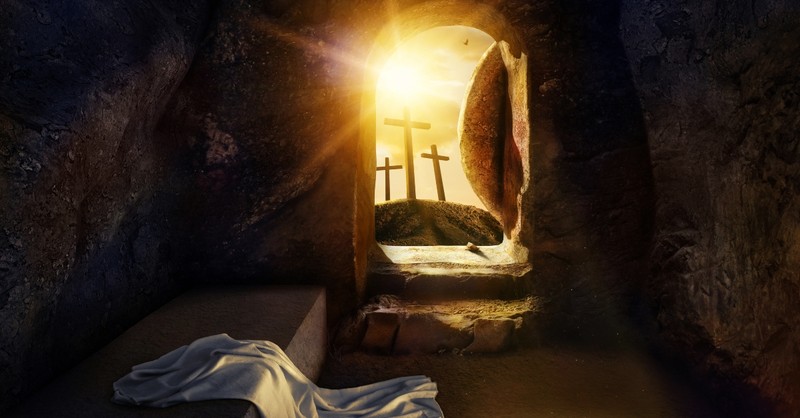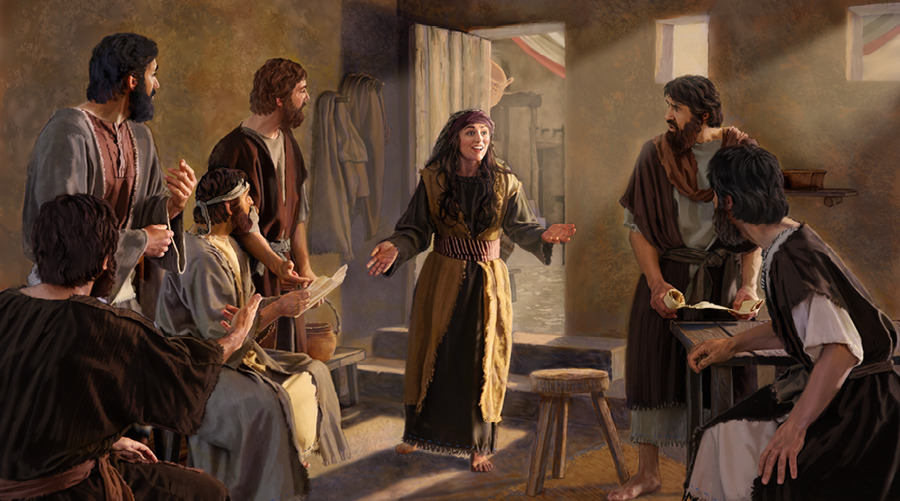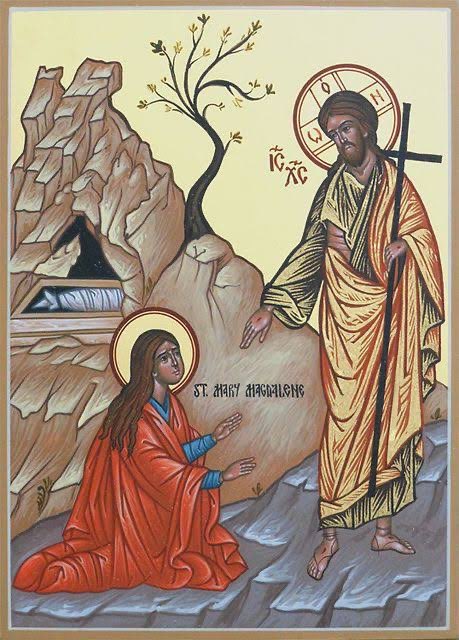
Each of the Gospels tells of the Resurrection of the crucified Jesus of Nazareth – or, more precisely, of the appearances of Jesus following his Resurrection. The actual moment of the Resurrection is not described by the Gospel writers, nor could it be, as the only person who was present is Jesus himself. The risen Jesus is concerned with his personal relationship with each person to whom he appears, not with describing the moment of the Resurrection.
Each of the appearances of Jesus of Nazareth involves a personal interaction, a personal conversation, a relationship of love. This is consistent with the remainder of the Gospels which are largely accounts of personal interactions, personal conversations, invitations to love. The Gospels are personalistic, both in style and substance.

Varying Accounts
The accounts of Jesus’ post Resurrection appearances vary, reflecting the particular perspective of the author of each Gospel, and of the witnesses upon whose recollection the Gospel writer drew. None of the Gospel accounts appear to have been edited, so as to eliminate differences of detail. So, the accounts are different in the way one would expect, the accounts of different witnesses, being somewhat different as to detail, reflecting their recollections, perspectives and personalities. To my mind, the four Gospel accounts are therefore psychologically very subtle, very convincing. When one receives a totally consistent account, even as to very precise and unimportant detail, from multiple witnesses, look for collusion!
“Miracles Never Happen”
If you take the starting position that miracles never happen, and that the Gospel accounts of the Resurrection of Jesus are therefore not to be believed, you will never accept the summary statement of the Apostles’ Creed – “on the third day he rose again from the dead” – nor of the Nicene Creed – “on the third day he rose again in accordance with the Scriptures.” You will have made your mind up in advance, despite the evidence, no matter what the evidence.
That starting position – that miracles never happen, and that the Gospels are therefore not to be believed – is the position of someone who rejects the transcendent almighty God of the Hebrews. The Hebrews understood that God works miracles.
If, as an observant Jew, one accepts a transcendent almighty God, one may accept the Gospel accounts, that, on the third day following his death on the Cross, and burial in the tomb, Jesus rose, in accordance with the Scriptures.

Mary Magdalene
Mary of Magdala, a town on the shore of the Lake of Galilee, was present, along with his mother, Mary, and other women, as well as the Apostle John, at the death of Jesus on the Cross.
Earlier, Mary Magdalene was said to have been rid of “seven devils”, some affliction, undoubtedly requiring a personal conversion. Mary Magdalene and the other women from Galilee, adopted a life of service, providing for Jesus and his Apostles out of their means. Mary Magdalene was present at the burial of Jesus, so there can be no doubt she was aware that Jesus was dead. Mary Magdalene and these other women were later among the first to announce Jesus’ Resurrection.
St John Paul II in his Apostolic Letter, Mulieris Dignitatem, paid great attention, not only to the importance of women in the mission of Christ and the Church, but also, with special emphasis on the particular role of Mary of Magdala as the first witness who saw the Risen Christ, and as the first messenger who announced the Lord’s Resurrection to the Apostles.
Confusion
Some scriptural commentary, in the absence of evidence, has blended Mary Magdalene with other women mentioned in the Gospels. One of the issues with some scriptural commentary, is the tendency to extrapolate conclusions not justified by a careful reading of the Gospels, and, most unfortunately, in some cases, a tendency to read scripture from some ideological perspective, rather than with the eyes of faith.
No Thought Jesus Had Risen
On the Sunday morning, after the Sabbath was over (Mary Magdalene, like most of Jesus’ followers, was an observant Jew), but while it was still dark, Mary came to the tomb, and found the stone rolled away from the entrance.
Life of Service
Mary had come, at the earliest possible time, as soon as the Sabbath was over, to anoint the dead body of Jesus, an act of service, what Christians have come to call a corporal act of mercy, an act of love, not extinguished by Jesus’ death. Since Mary’s conversion, since Mary, together with the other women, had become a follower of Jesus, her life had been a life of service, of love.
The whole point of what Mary Magdalene was intending to do, early that Sunday morning, was based on her knowledge that Jesus had died on the Cross, had been taken down from the Cross, laid in the arms of his afflicted Mother, and that his body had been hurriedly placed in the tomb of Joseph of Arimathea before the commencement of the Sabbath, late on Friday afternoon. There is no doubt, in Mary Magdalene’s mind, Jesus was dead.
Three times, early on the Sabbath, Mary Magdalene, by what she said, demonstrated her knowledge that Jesus was dead. Any other possibility defied Mary’s common sense. Mary Magdalene had no thought that Jesus had risen. Mary Magdalene knew Jesus was dead and buried. Mary Magdalene was there on Calvary when Jesus died.

Stolen Body
Mary Magdalene thought Jesus was the prey of grave robbers. “They have taken the Lord out of the tomb, and we do not know where they have laid him”, was what she told Peter and John. Mary Magdalene thought Jesus’ body had been stolen. That, to Mary’s mind, was the only possible explanation for its absence.
Some of the language here of seeking but not finding, possibly draws on the Song of Songs – which is about God’s love for the person, God’s love for his people Israel.
The reference to “we” in St John’s Gospel is consistent with Mary not having gone to the tomb alone, but with the other women who had been present at Jesus’ death on the Cross. St John’s account focuses on Mary Magdalen.
Grave Robbers
Mary did not go into the empty tomb, but stooped to look in. She saw two angels in white who asked her: “Woman, why are you weeping?” So, we find here reference to the presence of angels, reference which we find throughout the Hebrew Bible.
Mary Magdalene replied to the angels: “Because they have taken away my Lord, and I do not know where they have laid him.” Again, a second time, no thought other than that Jesus was dead. Again, a second time, Mary Magdalene thought Jesus was the prey of grave robbers. Theft was the only explanation which occurred to Mary Magdalene’s mind for the absence of Jesus’ body.
Woman
Mary Magdalene turned around, and saw Jesus standing, but did not at first know it was Jesus. Mary Magdalene was not expecting to see Jesus. Jesus said: “Woman, why are you weeping? Whom are you looking for?” The reference of Jesus in the Garden to “Woman”, is an allusion to that first woman, Eve, whose infidelity in the Garden, as recorded in Genesis, brought death to us all. By contrast, the fidelity of Mary Magdalene, standing by the wood of the Cross, joining in both the prayer of Jesus, and of his Mother Mary, and later, mourning in the Garden where Jesus’ tomb was to be found.
No Thought Other than that Jesus was Dead
Mary Magdalene said to Jesus, whom she believed to be the gardener: “Sir, if you have carried him away, tell me where you have laid him, and I will take him away.” Again, a third time, no thought other than that Jesus was dead. Mary Magdalene is a stubborn woman, full of common-sense. Mary Magdalene’s love for Jesus is not broken by death. But to Mary Magdalene’s mind, Jesus is dead. Any alternative is impossible.

Called by Name
Jesus said: “Mary.” When called by her name, Mary Magdalene immediately recognised Jesus. Jesus calls each of us by name. Will we recognise him?
Mary Magdalene turned and said to Jesus in Hebrew: “Rabboni!” (which means Teacher). Mary Magdalene, recognises Jesus as Divine Wisdom, as Truth.
In Communion with the Father
Jesus said: “Do not hold on to me, because I have not yet ascended to the Father. But go to my brothers and say to them, ‘I am ascending to my Father and your Father, to my God and your God.'”
Pope Benedict XVI/ Joseph Ratzinger addresses this passage specifically:
She wants to touch him, to hold him, but the Lord says to her: ‘Do not hold me, for I have not yet ascended to the Father.’ This surprises us. We would have thought that now, while he is standing before her, she can indeed touch him and hold him. When he has ascended to the Father, this will no longer be possible. But the Lord says the opposite: ‘Now she cannot touch him or hold him. The earlier way of relating to the earthly Jesus is no longer possible…The old manner of human companionship and encounter is over. From now on, we can touch Jesus only “with the Father.” Now we can touch him only by ascending. From Jesus’ perspective, in his communion with the Father, he is accessible and close to us in new ways.’
This new accessibility presupposes a newness on our part as well. Through baptism our life is already hidden with Christ in God – in our current existence we are already ‘raised’ with him at the Father’s right hand. If we enter fully into the essence of our Christian life, then we really do touch the risen Lord, then we really do become fully ourselves. Touching Christ and ascending belong together. And let us not forget that for John the place of Christ’s ‘exaltation’ is his Cross, and that our own ever necessary ‘ascension’, our ‘going up on high’ in order to touch him, has to be travelled in company with the crucified Jesus.
I Have Seen the Lord
Mary Magdalene announces to the disciples: “I have seen the Lord.” As Pope Francis explains: “I have changed my life because I have seen the Lord! I am now different than before. I am another person. I have changed because I have seen the Lord. This is our strength, and this is our hope.” Mary Magdalene is a witness to Divine Mercy, an Apostle to the Apostles, the Evangelist to the Evangelisers.

Feast Day
In 2016, Pope Francis, recognising the role of Mary Magdalene, the first person to whom Jesus newly risen appears, raised the Memorial of St Mary Magdalene on 22 July to a Feast Day. The Feast Days in the Roman Calendar are mainly feasts of the Apostles and Evangelists. It is appropriate that on 22 July we celebrate the Feast Day of St Mary Magdalene, the first person to whom the Risen Jesus appears-and one of the women who accompanied Jesus on the Cross. It is appropriate because, with the exception of St John, it was the women who remained faithful at the Crucifixion.
As the biblical scholar NT Wright has commented, Mary Magdalene and other women were first at the empty tomb, first to meet the risen Jesus, the first to tell others they had seen him. Nobody in the ancient world, wanting to convince sceptics, would have made that up. Women were not regarded as credible witnesses.
St Mary’s Cathedral
About the same time as the institution by Pope Francis of the Feast of St Mary Magdalene, there appeared in St Mary’s Cathedral in front of the main altar two stone figures, Mary Magdalene on her knees greeting the Risen Christ in the Garden!
St Paul on the Resurrection
The importance of the Resurrection of Jesus is explained by St Paul in the First Letter to the 1 Corinthians 15:
If there is no resurrection of the dead, then not even Christ has been raised. And if Christ has not been raised, our preaching is useless and so is your faith. More than that, we are then found to be false witnesses about God, for we have testified about God that he raised Christ from the dead. But he did not raise him if in fact the dead are not raised. For if the dead are not raised, then Christ has not been raised either. And if Christ has not been raised, your faith is futile; you are still in your sins.
How Do We Understand This?
Accepting the Gospel accounts of the Resurrection of Jesus of Nazareth, how do we understand the Resurrection in contemporary terms? Pope Benedict XVI/Joseph Ratzinger provides the best answer:
It is a historical event that nevertheless bursts open the dimensions of history and transcends it.…The man Jesus complete with his body now belongs totally to the sphere of the Divine and Eternal…Essential, then, is the fact that Jesus’ Resurrection was not just about some deceased individual coming back to life at a certain point, but that an ontological leap occurred, one that touches being as such, opening up a dimension that affects us all, creating for all of us a new space of life, a new space of being in union with God… Jesus’ Resurrection points beyond history but has left a footprint within history.
The Resurrection is a truth which we will only appropriate with faith. Mary of Magdala helps us recognise the Risen Christ, appropriating the truth of the Resurrection, and so, with Christ, helping us, we ascend to the Father, at the same time announcing the Resurrection to our brothers and sisters.
